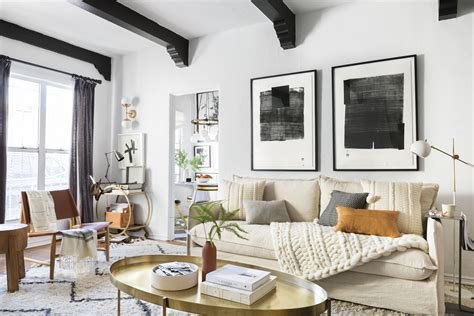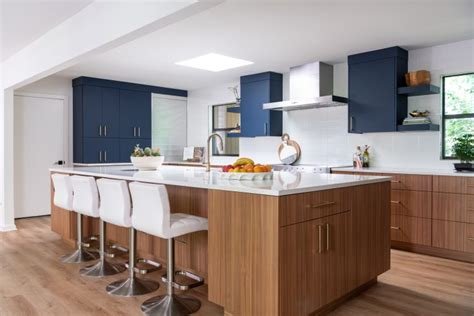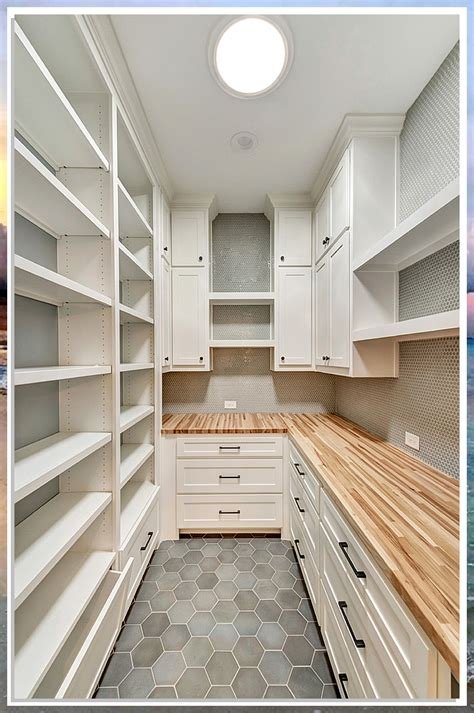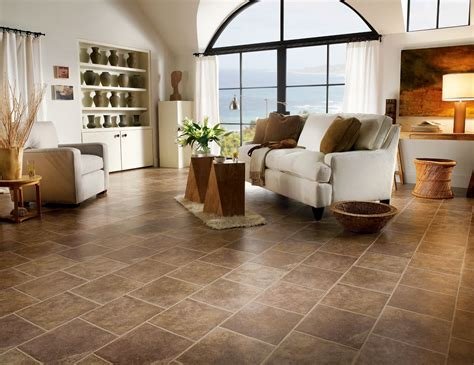In the blog post Top 10 Interior Design Ideas to Refresh Your Living Space, readers are introduced to innovative ways to revitalize their homes. It delves into key factors influencing modern design trends, emphasizing the importance of color in setting mood and atmosphere. The article showcases the top 10 furniture arrangements perfect for small spaces, explores the role of technology in contemporary design, and presents functional yet stylish storage solutions. Additionally, it highlights how textiles can enhance comfort and aesthetic appeal, while also recognizing the critical role of lighting in creating ambiance. The article concludes by advocating for environmentally-friendly practices in interior design, encouraging readers to bring their design ideas to life. Overall, the post serves as a rich resource for those looking to update their living spaces with practical and stylish tips.
Introduction to Top 10 Interior Design Ideas
Refreshing your living space can be a rewarding experience, bringing new life and energy into your home. Whether you are revamping an entire room or simply updating a few elements, implementing new interior design ideas can significantly enhance the overall aesthetic while also improving functionality. This is where the Top 10 interior design ideas come into play, offering fresh perspectives and creative solutions.
One of the initial steps in this journey is understanding why a refresh is necessary. It’s not just about changing the look; it’s about creating a space that reflects your personal style and meets your needs. An updated design can result in improved comfort, increased happiness, and even a boost in your home’s market value. Consider the following reasons for refreshing your living space:
- To enhance your home’s aesthetic appeal
- To increase functionality and comfort
- To adapt to changing lifestyle needs
- To reflect personal growth and style
- To improve your home’s energy efficiency
- To increase property value for potential resale
As you explore various design concepts, keep in mind that every choice carries significance. From color schemes to furniture arrangements, each element contributes to the overall feeling of your space. Experimenting with different styles can lead to exciting and unexpected results, making it essential to stay open-minded and flexible throughout the design process. Remember, good design harmonizes with your lifestyle and enhances daily living.
“Design is not just what it looks like and feels like. Design is how it works.” – Steve Jobs
Incorporating the Top 10 interior design ideas will empower you to create a space that not only resonates with your unique taste but also serves your practical needs. Take the time to research, plan, and imagine; the possibilities are endless when it comes to transforming your home into a sanctuary of comfort and beauty.
Key Factors Influencing Modern Interior Design Trends
As we delve into the world of interior design, it becomes evident that various elements shape the trends we observe today. Understanding the key factors influencing these trends is essential for anyone looking to refresh their living space. By analyzing how design evolves, we can create environments that align with contemporary aesthetics and functional needs. Here, we highlight several influential factors that marry style with practicality in modern interior design.
Essential Elements to Consider
- Functionality: Spaces should complement the way we live.
- Aesthetics: Visual appeal is crucial for creating inviting environments.
- Sustainability: Eco-friendly materials and practices are on the rise.
- Space Optimization: Efficient use of space enhances comfort.
- Technological Integration: Smart home solutions are becoming standard.
- Personal Style: Designs should reflect individual tastes and preferences.
- Trends: Staying updated with current trends can inspire your designs.
In addition to these elements, focusing on sustainability has emerged as a significant trend in modern interior design. Many designers and homeowners prioritize environmentally friendly materials and practices, leading to the creation of interior spaces that are not only beautiful but also conscientious. By incorporating recycled materials, energy-efficient appliances, and sustainable furnishings, you can create a living space that supports the planet and fosters well-being.
Sustainability Trends
This shift towards sustainability is driven by a growing awareness of environmental impact and a desire for healthier living. Designers today are increasingly using renewable resources, low-VOC paints, and energy-efficient lighting solutions, ensuring that aesthetic choices do not compromise ecological responsibility. By choosing sustainable designs, you can cultivate a home that feels right, both inside and out.
Color Psychology
Another critical factor influencing modern interior design is the psychology of color. Different hues evoke various emotions and moods, making them essential in crafting the atmosphere of your spaces. For instance, calm blues can induce a sense of tranquility, while vibrant yellows may stimulate energy and creativity. Understanding how colors affect human perception helps in selecting palettes that not only appeal visually but also enhance the overall ambiance of your home.
Using Color to Create Mood and Atmosphere
Color is a powerful tool in interior design, capable of transforming a space and influencing emotions. When selecting colors for your living space, it’s essential to understand how different hues can evoke various feelings. This understanding allows you to create a desired mood, whether it be calm and serene or vibrant and energizing. By thoughtfully choosing your palette, you can enhance your living environment and make it more reflective of your personality and lifestyle.
One effective way to utilize color is through specific palettes that resonate with your vision for the space. Top 10 color schemes are prevalent now, each offering a unique ambiance. For instance, combining warm shades can create a cozy atmosphere, while cooler tones promote tranquility. The integration of these palettes can also influence how light interacts with your room, enhancing the overall aesthetic.
Popular Color Palettes
- Soft neutrals: Beige, cream, and light gray for a calm foundation.
- Earthy tones: Terracotta, olive, and brown for warmth and comfort.
- Cool blues: Sky blue and teal for a refreshing, peaceful vibe.
- Bright accents: Yellow and coral for cheerful pops of color.
- Monochromatic schemes: Shades of a single color for sophistication.
- Pastel hues: Mint, lavender, and peach for a playful, soothing feel.
- Bold contrasts: Black and white for drama and timeless elegance.
When deciding on your color choices, it helps to consider the location and lighting of the room. Different environments will interact with colors uniquely, influencing how they appear throughout the day. A space bathed in natural light may enhance the vibrancy of colors, while dimly lit rooms may need more saturated hues to avoid feeling dull. Your goal should be to create a harmonious balance that suits both the function and mood of the space.
Calming Colors
Calming colors, such as soft blues and greens, tend to promote relaxation and focus. These colors are ideal for spaces meant for unwinding, such as bedrooms or reading nooks. The psychological effects of these hues help reduce stress, making your environment feel serene and welcoming. By layering calming tones with textured fabrics or natural materials, you can further cultivate a tranquil atmosphere.
Vibrant Shades
On the other hand, vibrant shades like yellows and reds inject energy into your living space. These colors are great for communal areas, such as living rooms and kitchens, where social interaction occurs. Using vibrant accents, like throw pillows or artwork, can stimulate creativity and positivity, making the space feel lively and inviting. Thoughtfully integrating these colors can transform your home, making it not just beautiful, but also a joyful environment.
Top 10 Furniture Arrangements for Small Spaces
When dealing with limited square footage, maximizing space through thoughtful furniture arrangements is essential. Small spaces can often feel cluttered and cramped; however, with the right layout, they can also be inviting and functional. Prioritizing multi-functional furniture and strategic placement will not only enhance the aesthetics of your living area but also optimize usability.
A crucial element in making the most of small spaces is ensuring that each piece of furniture serves a purpose. Consider the flow of movement in your space and arrange furniture in a way that allows for easy navigation. The right arrangement can dramatically change the perception of size within the room, making it feel larger and more open.
Incorporating mirrors can also give the illusion of space while reflecting light, which enhances the overall ambiance of your room.
To ensure that your small space feels both cozy and functional, follow these Steps to Optimize Space:
- Choose furniture with built-in storage.
- Opt for lighter colors and materials to create an airy feel.
- Place larger pieces of furniture against walls to open up the central area.
- Incorporate multi-functional items, such as a sofa bed.
- Utilize vertical space by installing shelves or wall-mounted units.
- Consider using foldable furniture for versatility.
- Keep pathways clear to avoid a congested appearance.
By following these steps, you can create a harmonious and stylish environment in even the tiniest of spaces. Remember, the key to a successful furniture arrangement in small areas is to be intentional with your choices and to prioritize both function and design aesthetics.
Incorporating Technology Into Your Design
In today’s fast-paced world, incorporating technology into your interior design is more than just a trend; it’s a necessity for creating functional and stylish living spaces. The digital advancements available today can enhance not only the aesthetic appeal of your home but also its practicality and efficiency. By blending cutting-edge gadgets with innovative design principles, you can create spaces that reflect your personal style while offering unprecedented convenience. Embracing these solutions can transform your home into a modern oasis that caters to all your needs.
One of the best ways to enhance your design is through the use of smart devices. These gadgets can help you control various aspects of your environment, making your living experience more enjoyable. Additionally, you can elevate your design theme while incorporating functionality seamlessly. From smart lighting to temperature control, modern technology can help you achieve the perfect ambiance in each room. Consider the following list of Tech Gadgets for Home that can help you elevate your interior design:
- Smart LED Bulbs
- Smart Thermostat
- Voice-Controlled Assistants
- Wireless Speakers
- Smart Security Cameras
- Smart Rugs
- Automated Curtains
Integrating these devices into your home will not only enhance its functionality but also contribute to a more cohesive design. Keep in mind that the key to a successful integration of technology and design lies in selecting products that align with your overall aesthetic while providing genuine value to your daily life.
Smart Lighting
Smart lighting is an essential component of modern interior design. These innovative lighting systems allow you to customize brightness and color, set schedules, and even control lights remotely via smartphone apps. This level of flexibility can dramatically change the atmosphere in your home, making it vibrant during social gatherings and cozy during quiet moments. Moreover, the energy efficiency of smart lights can also contribute to cost savings in the long run.
Temperature Control
Temperature control systems, such as smart thermostats, offer an unparalleled advantage when it comes to maintaining comfort in your living space. These devices learn your routines and preferences, allowing them to adjust the heating and cooling automatically. This not only helps create a pleasant environment but also reduces energy consumption, which is beneficial for both the planet and your utility bills. By seamlessly blending technology and design, you can create a truly harmonious living space that meets your needs while looking great.
Creating Functional and Beautiful Storage Solutions
Storage solutions play a crucial role in maintaining an organized and visually appealing living space. By combining function and aesthetics, you can create areas within your home that not only serve their purpose but also enhance your interior design. Implementing the right storage strategies will help you declutter while contributing positively to your home’s overall atmosphere. Remember that effective storage isn’t merely about practicality; it can also be a pivotal aspect of your decoration style.
When crafting the perfect storage, consider furniture that serves dual purposes. For example, ottomans with hidden compartments or coffee tables that double as storage units are excellent choices. These pieces not only provide necessary functionality but also fit seamlessly into your design scheme. Furthermore, personalized storage solutions can reflect your unique style, often serving as statement pieces in your living areas.
Tips for Effective Organization
- Identify your storage needs based on your lifestyle.
- Choose multi-functional furniture that maximizes use and space.
- Utilize vertical space with shelves and cabinets.
- Incorporate decorative boxes and baskets for a stylish touch.
- Maintain consistent organization practices to avoid clutter.
Emphasizing aesthetics with functional storage can significantly transform your living space. As you evaluate your available space, also think about how built-in storage solutions can minimize clutter while elevating the design of your room. Custom cabinetry or floating shelves can create a stunning display of your favorite items, transforming a simple storage area into a focal point of the room. Ultimately, the aim is to create a cohesive look that seamlessly integrates beautiful storage solutions into your existing decor.
Using Textiles to Enhance Comfort and Style
Incorporating textiles into your living space is an essential aspect of modern interior design. Textiles not only add a layer of comfort and warmth to your environment but also serve as a powerful tool for style enhancement. The way you choose to use fabrics—be it through rugs, curtains, or upholstery—can significantly influence the overall aesthetic of your home. This section will explore various textile options that can help you achieve a balanced and inviting living space.
Textile Options for Living Spaces
- Cotton: Versatile and easy to maintain, perfect for casual spaces.
- Linen: Offers a natural look with a relaxed feel, ideal for summer.
- Wool: Great for rugs and throws, adding warmth and durability.
- Silk: Adds a touch of luxury and elegance, best used for curtains.
- Velvet: Soft and rich in texture, excellent for accent chairs and cushions.
- Chenille: Provides a cozy feel, perfect for sofas and blankets.
- Acrylic: Affordable and versatile, suitable for various decor styles.
When thinking about textiles, rugs are often the first element that comes to mind. A well-chosen rug can tie together the different components of your room, creating a cohesive look while adding comfort underfoot. Rugs can define spaces, especially in open plans, helping to separate areas for different purposes—like a living area from a dining space—thanks to their variety of sizes, colors, and patterns.
Rugs
Selecting the right rug is crucial for enhancing both comfort and style. Look for rugs that complement your existing decor or introduce a new element to your design. Additionally, consider the material and texture to ensure that it aligns with your lifestyle—whether you have pets, kids, or simply prefer easy maintenance. A plush wool rug can provide softness, while a flatweave option might be more practical in high-traffic areas.
Another key textile element in enhancing your living area is curtains. They offer privacy and light control while adding style and color to your windows. Opting for the right fabric and pattern can transform a room’s aesthetics completely. Sheer fabrics allow natural light to filter through while providing a soft look, whereas heavier drapes can create a sense of drama and intimacy.
Curtains
When choosing curtains, consider both functionality and decor. Floor-length curtains can create an illusion of height, making your space feel larger and more airy. Additionally, layering different types of curtains, such as sheer and blackout options, can provide versatility and enhance the overall design. Whether you choose bold patterns or solid colors, the right curtains can complete the look, making your living area more inviting and stylish.
Lighting: The Unsung Hero of Interior Design
When it comes to interior design, many people often overlook the significance of lighting as they focus on furniture and color schemes. However, lighting plays a crucial role in shaping the atmosphere of a living space. It can create an inviting ambiance, highlight architectural features, and set the mood for various activities. Therefore, overlooking the power of effective lighting can detract from even the most beautifully designed rooms.
Top 10 interior design ideas should always prioritize lighting as the essential backbone of the aesthetic. The right lighting choices enhance both the visual appeal and functionality of each room. Consider different types of lighting, including ambient, task, and accent lighting, to create layers that complement your overall design. Experimenting with various fixtures can lead to a more dynamic and engaging environment.
Incorporating natural light is another crucial aspect of optimizing lighting. Large windows, skylights, and reflective surfaces can help enhance the brightness of your space while also promoting an eco-friendly atmosphere. For those with limited access to natural light, strategically placing mirrors can amplify the effect of artificial lights. Here’s a quick guide on how to effectively optimize your lighting:
Steps to Optimize Lighting
- Assess your room layout and determine where light is most needed.
- Incorporate multiple layers of lighting—ambient, task, and accent.
- Utilize natural light sources by keeping windows unobstructed.
- Choose the right light fixtures that align with your design style.
- Consider dimmable lighting for versatility in atmosphere.
- Add reflective surfaces like mirrors to amplify light.
- Use color temperature wisely to create the desired mood.
By integrating these lighting steps, you will elevate your living space into a well-designed area that reflects your personal style. Ultimately, the right lighting can transform a dull room into a captivating visual experience. Remember, your lighting choices not only illuminate your space but also define its character and comfort level.
Environmentally-Friendly Interior Design Practices
Incorporating Top 10 environmentally-friendly interior design practices can significantly enhance both the aesthetic and ecological value of your living space. Many homeowners are increasingly conscious of their environmental impact and are looking for ways to create a more sustainable home. By embracing eco-friendly materials and practices, you can not only refresh your surroundings but also contribute to a greener planet.
One of the best approaches to sustainable interior design is through the thoughtful selection of materials. Opting for natural, recycled, or upcycled products ensures that your design choices are not only stylish but also contribute to resource conservation. For instance, using reclaimed wood furniture adds character to your space while minimizing deforestation impact. Investing in eco-friendly paints and finishes that have low volatile organic compound (VOC) content further promotes indoor air quality.
- Sustainable Practices for Your Home
- Utilize energy-efficient appliances to reduce energy consumption.
- Choose bamboo or cork flooring as they are rapidly renewable resources.
- Incorporate indoor plants to improve air quality and enhance aesthetics.
- Install LED lighting to lower electricity usage and provide better illumination.
- Use recycled glass or metal accents in décor to minimize waste.
- Select furniture made from sustainably sourced materials.
- Repurpose or upcycle old furniture instead of purchasing new items.
Additionally, focusing on water conservation and energy efficiency is key to achieving an environmentally-friendly interior space. This can involve simple updates like installing low-flow faucets or energy-efficient windows that prevent heat loss. By harmonizing the principles of design with sustainable practices, homeowners can create a stylish yet responsible living environment that honors both personal taste and planetary health.
Design is not just what it looks like and feels like. Design is how it works. – Steve Jobs
Conclusion: Bringing Your Interior Design Ideas to Life
Embracing the Top 10 interior design ideas explored above can significantly enhance your living space, making it not only aesthetically pleasing but also functional and comfortable. Each concept has its own unique advantages, depending on your personal style and the specific requirements of your home. Whether you’re planning a complete overhaul or looking to make subtle changes, understanding these principles will allow for a more cohesive and polished result.
As you embark on this journey, remember that personalization is key. Your space should reflect who you are; thus, don’t hesitate to infuse your personality into your design choices. Incorporating elements that resonate with you—be it through color, texture, or furnishings—will ensure that you create a home that feels uniquely yours. As trends evolve, so should your approach to design.
Interior design is not just about aesthetics; it’s about creating a space that elevates your everyday experiences.
To implement these strategies effectively, consider the following Actionable Takeaways that summarize the essential steps to bring your design ideas to fruition:
- Assess your existing space to determine what elements need refreshing.
- Choose a color palette that resonates with your desired mood and atmosphere.
- Select furniture arrangements that optimize the flow and functionality of each room.
- Incorporate technology to enhance convenience and modernity in your design.
- Utilize textiles for added comfort, warmth, and visual interest.
- Plan for ample lighting to highlight key features and set the desired ambiance.
- Consider sustainable practices in your design choices to support eco-friendly living.
With a thoughtful approach to these Top 10 interior design ideas, you can create a space that not only meets your practical needs but also elevates your lifestyle. Let your creativity shine, and remember that each decision counts towards building a home that feels welcoming and stylish.









